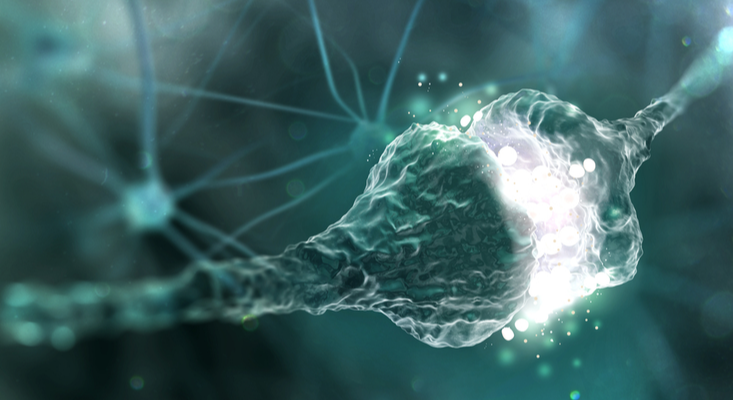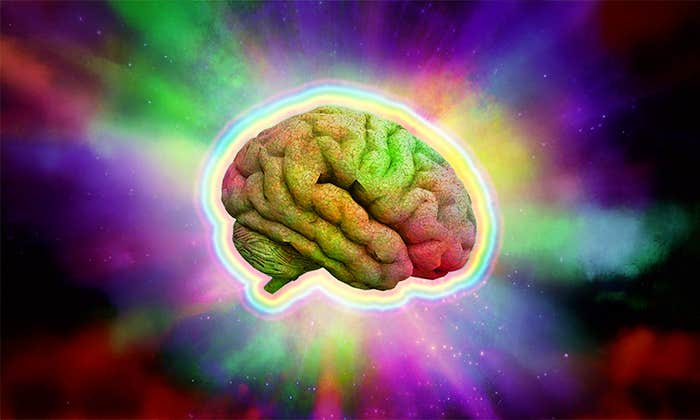Imagine that someone asked you to come up with a sequence of five words. In any other year, some idiosyncratic combination would likely come to mind. This year, though, one five-word sequence that has been etched into the memories of many Americans, and many worldwide, stands out—“person, woman, man, camera, TV.” Donald Trump, touting his ability to memorize these words as part of a cognitive health test, made the sequence famous. (The comedian Sarah Cooper also gave it a boost with her viral YouTube video, “How to person woman man camera tv.”)
We can tie together our personal experiences and acquired knowledge—such as this memory of Trump’s behavior—into interconnected memories, recallable at a moment’s notice. The fact that our healthy brains can do this can seem mundane and unremarkable. After all, we often experience the phenomenon of memory, with the exception of cramming for tests and the like, quite effortlessly. Our ability to remember a simple five-word sequence, or the events of a birthday five years ago, and the fact that a question, or a sight or smell, can recall these memories is, if you can stop taking it for granted for a moment, astounding. If you have an intact memory system, you might do well finding time to appreciate it.

I did so recently, contemplating a recent paper from Rodrigo Quiroga, who directs the Center for Systems Neuroscience at the University of Leicester. You may recall his work on “Jennifer Aniston neurons”—the idea, much reported on in the early aughts, that specific brain cells represent highly detailed concepts, be they objects or people. Many neurons in the human medial temporal lobe have these “concept cells,” the behavior of which has yet to be observed in any other animal. It was only medical happenstance, involving patients with intractable epilepsy undergoing intracranial recordings, that provided scientists the chance to take this rare peek at the human brain. Quiroga, in a 2012 Nature Review Neuroscience paper, argued that the “sparse, explicit and abstract representation of these neurons is crucial for memory functions, such as the creation of associations and the transition between related concepts that leads to episodic memories and the flow of consciousness.”1
Quiroga’s new paper, “No Pattern Separation in the Human Hippocampus,” is something of a sequel to his idea about Jennifer Aniston neurons. He builds on how concept cells could be incredibly important for our ability to form and recall memories, while simultaneously making us better at several other cognitive abilities. “I propose,” he writes, “that a lack of pattern separation in memory coding may have profound implications that could explain cognitive abilities that are uniquely developed in humans, such as our power of generalization and of creative and abstract thinking.”
The human hippocampus, a tiny seahorse shaped structure, seems to have a hand in everything from spatial navigation to memory. It, along with the surrounding para-hippocampal regions and cortex, forms the medial temporal lobe, a sensory hub that allows us to form and store declarative memories—memories of personal experience and factual information.2 Many of the sensory signals the medial temporal lobe receives have been heavily processed by the rest of the brain. These signals tend to represent more complex concepts, allowing neurons in the medial temporal lobe to respond to rich features in the world. Quiroga contends that we can form and use these memories in ways unique to us, without the pattern separation seen in many other species, undergirding what makes us special.
It is this ability to separate slightly, but not completely, that might lie at the heart of our ability to notice similarities between different things.
Pattern separation is principally used by the brain to convert rich representations into distinguishable declarative memories. For example, consider two events represented by different neurons in the medial temporal lobe that reliably follow one another, such as hearing “person” and then hearing “woman.” The neural representations of each word in this pair will be strung together by changes in the connections between the “person” and “woman” neurons. This allows for a combined pattern of neural activity in the medial temporal lobe to represent a sequence—the word “person” followed by “woman.” In this way, concepts and events can be linked together, giving rise to the formation of associations and memories.
Once these memories are formed, a partial prompt can easily have you recollect them. Asking what follows the word “person” activates the medial temporal lobe’s activity pattern for memories associated with that word. A key feature of this region of the brain is its ability to complete these partial patterns of activity. Activating the “person” pattern activates the pattern for “woman,” allowing us to remember the sequence.
Now imagine learning two separate sequences of words—“person, woman, man,” and “person, camera, TV.” Both of these sequences could activate the “person” neurons in the medial temporal lobe, which will then be completed by the brain, activating other neurons relating to words in both of the sequences. To prevent this mixing up of memories from taking place, the medial temporal lobe performs a computation that separates the two sequences. This lets two completely different sets of neurons represent these two sequences.
This ability to perform pattern completion and pattern separation is crucial. Without it, we couldn’t form and recollect distinct and meaningful memories since many aspects of any two memories would otherwise overlap. Evidence from experiments in mice, rats, monkeys, and even some fMRI studies in humans support the idea that the medial temporal lobe represents the world in this way—and that the hippocampus in particular performs both pattern completion and pattern separation.3
But Quiroga believes that the human medial temporal lobe doesn’t pattern-separate in exactly this way. He suggests that the human brain uses a different manner of representing the world. The fMRI studies, he argues, seem to indicate that the human medial temporal lobe performs pattern separation because fMRI imaging doesn’t have the resolution to capture the activity of individual neurons. When you record the activity of these single cells, a different picture, Quiroga contends, emerges.
The remarkable selectivity that neurons show, Quiroga argues, isn’t absolute. Imagine he teaches you to link, say, Jackie Chan with two other actors, Chris Tucker and Bruce Lee, so that there are two actor pairs, with Jackie Chan being in both. With pattern separation, these two associations—between Jackie Chan and Chris Tucker, and Jackie and Bruce Lee—would be represented by completely different groups of cells. That is, the cells representing Jackie Chan in one pair would not represent Jackie Chan in the other pair.
What Quiroga notes is that when individual neurons are observed after the associations are made, some Jackie Chan cells respond to images of Chris Tucker or Bruce Lee. Both patterns share a commonality—some of the Jackie Chan cells. Quiroga says it is this ability to separate slightly, but not completely, that might lie at the heart of our ability to notice similarities between different things, spurring the creation of novel ideas.
There’s ample room to be skeptical of Quiroga’s case about human uniqueness. Representing the world using cells that respond to such specific concepts is computationally impractical, some scientists have pointed out.4 One would need a new cell for each and every new concept while our brains have a limited number of neurons. They suggest an alternative theory in which concepts are represented by a unique pattern of activity where any given cell could respond to many more different concepts than Quiroga posits in his model while allowing the pattern as a whole to remain unique. It is unclear how the link between representations and memories Quiroga suggests would change if the representation of the world did not make use of concept cells.
Another argument involves evolution and applies Occam’s razor—the simplest explanation is usually the right one. Turtles that live in the ocean are able to learn general rules that allow them to land on the same beach year after year to lay eggs, despite the fact that the objects and features of the aquatic world that they use to navigate changes constantly. Elephants in India are known to use innovative ways to identify and break down electric fences once they have associated these fences with pain. Neuroscientists have become increasingly interested in birds like the crow, which appear to be able to think creatively in ways that mirror human cognition. All three of these species have brains that seem as different from humans brains as they are from the brains of animals that do show pattern separation.
There are likely many more impressive examples of generalization and creativity within the rest of the animal kingdom—of which we are of course a part. Does it make sense to suspect that these animals, all lying on very different branches of the evolutionary tree, also do not pattern-separate? Seems unlikely. It would mean a lack of pattern separation evolved independently at least four different times. It is more parsimonious to suppose that we and these animals do the same thing and can therefore perform amazing feats of creativity and generalization.
One possibility is that overlapping representations may amount to an intermediate step of pattern separation, rather than the signature of its absence in humans. Recording neurons from a slightly different location in the medial temporal lobe might reveal what Quiroga believes is missing. Alternatively, perhaps experiments done in non-human animals may be too simplistic to see the lack of pattern separation that Quiroga sees in his human experiments. In any case, it seems we need more evidence, from experiments in both humans and non-human model organisms, to see if the ideas that Quiroga hypothesizes are true. For now, as the aphorism goes: Absence of evidence is not necessarily evidence of absence.
Adithya Rajagopalan is a graduate student in the department of neuroscience at Johns Hopkins University & Janelia Research Campus. Follow him on Twitter @adi_e_r.
References
1. Quiroga, R.Q. Concept cells: The building blocks of declarative memory functions. Nature Reviews Neuroscience 13, 587-597 (2012).
2. Eichenbaum, H. A cortical-hippocampal system for declarative memory. Nature Reviews Neuroscience 1, 41-50 (2000).
3. Yassa, M.A. & Stark, C.E.L. Pattern separation in the hippocampus. Trends in Neuroscience 34, 515-525 (2011).
4. deCharms, R.C. & Zador, A. Neural representation and the cortical code. Annual Review of Neuroscience 23, 613-647 (2000).
Lead image: Brian Gallagher


























